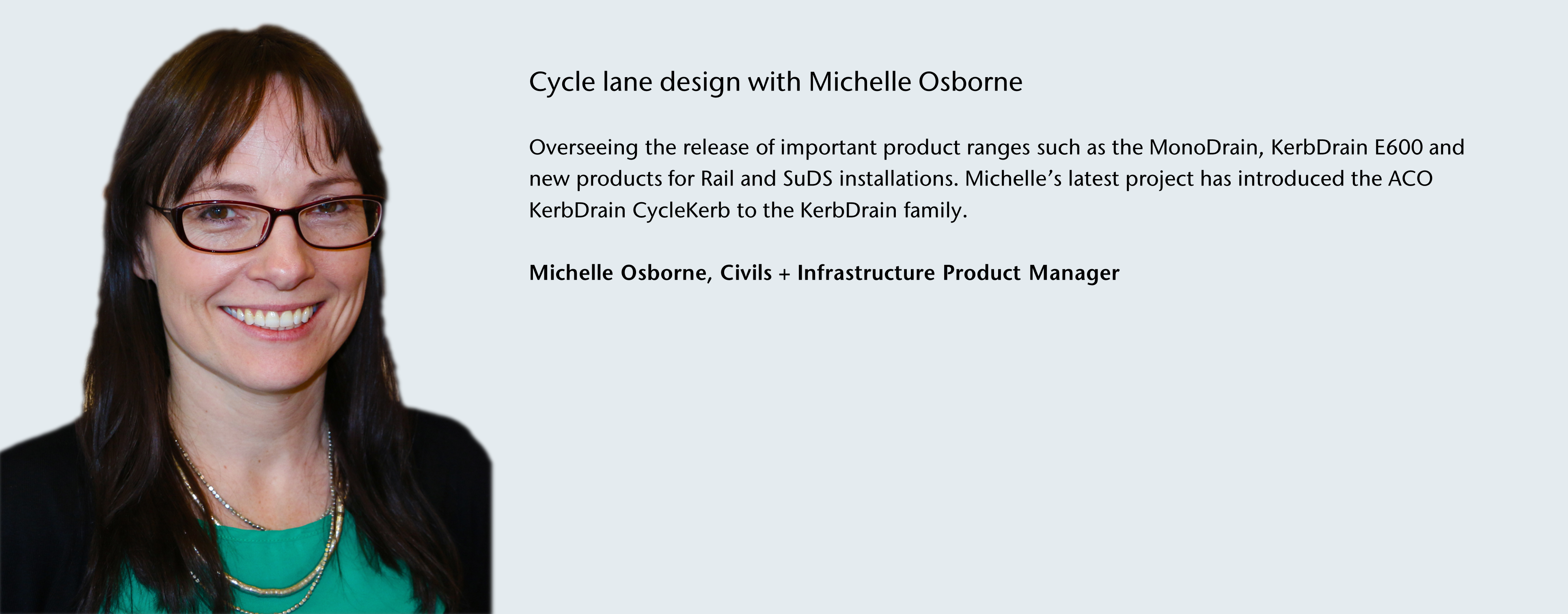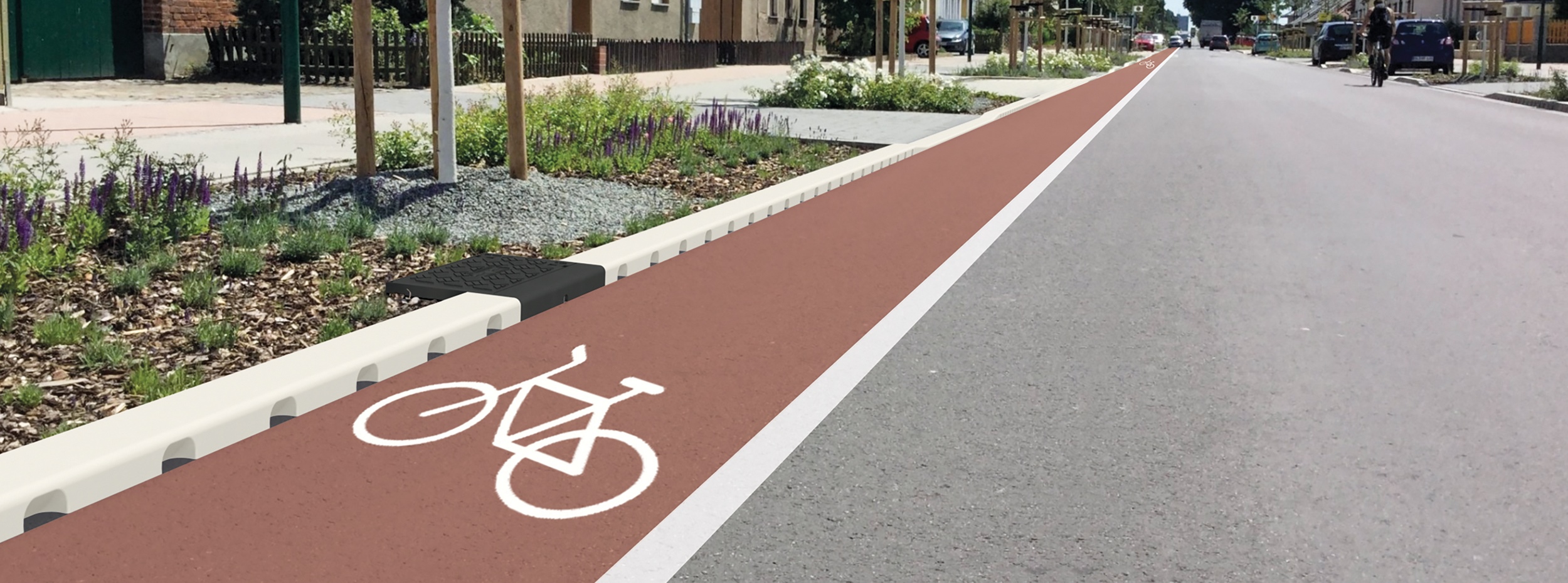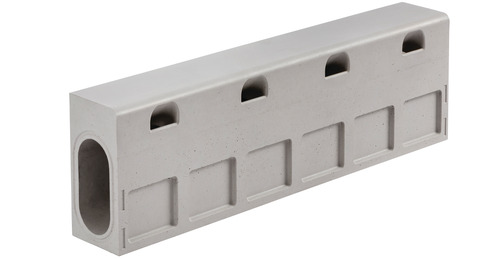ACO KerbDrain® CycleKerb Q&A
Interview with Michelle Osborne ACO Project Manager

Inspired by the surge in cycling during the pandemic and new initiatives for active travel, Michelle Osborne, Product Manager – Civils + Infrastructure at ACO Water Management and her team undertook a collaborative effort with cyclists, specifiers, and the Highways Agency that resulted in ACO’s latest kerb drain solution: CycleKerb.
Here, Michelle answers some key questions on the process of creating CycleKerb and how it improves safety for all road users while providing effective surface water drainage.
What inspired the development of CycleKerb, and how did feedback from cyclists and authorities influence its design?
We saw during the COVID pandemic that there was a significant uptake in cycling as people looked for safe and healthy transportation options. This, coupled with government funding initiatives for active travel, acted as a bit of a catalyst for creating CycleKerb.
As part of the development process, we sought feedback from cyclists and engaged with authorities to understand their concerns. Their input played a pivotal role in shaping CycleKerb's design.
This synergy between user feedback and official input was crucial in creating a product that not only meets industry standards but also addresses the needs of cyclists and communities. We're proud to say that CycleKerb is a product of collective vision and dedication to safe and accessible cycling infrastructure.
Can you explain how CycleKerb improves safety for cyclists and reduces conflicts with motorists?
Cyclists’ safety is at the core of CycleKerb's design, and there are a number of features that contribute to this. We've designed CycleKerb's inlets to allow quick removal of surface water during large storm events, and from a visual perspective the inlets are not only discreet but aid pedestrian awareness of the level change at non-crossing areas. Also, because it presents a physical barrier, it helps keep cycle lanes clearly marked out from the pedestrian zone, and within a stepped system reduces unwanted intrusions by motor vehicles into the cycle lane. It's like having a safety buffer that enhances visibility and reduces the likelihood of these three user groups unexpectantly crossing paths.
Additionally, because of CycleKerb's unique design with inlets on the vertical face, there’s no need for horizontal inlets that could pose hazards to pedestrians and cyclists. This design also means there are no sudden breaks or irregularities in the cycle lane's surface, thereby contributing to a smoother and safer riding experience.

Can CycleKerb be incorporated into existing kerb systems?
Existing systems can be easily integrated with CycleKerb which makes it a practical choice for new developments and retrofitting. There are three key reasons why this is the case:
1. Flexible installation: CycleKerb comes in easily customisable sections to fit various widths and configurations, making it connectable to existing pipe systems often without the need for extensive alterations.
2. Minimal disruption: CycleKerb minimises the disruption typically associated with retrofitting because it's designed for easy installation. The whole process can be completed relatively quickly, reducing inconvenience to road users and nearby residents.
3. Compliance with standards: CycleKerb is engineered to meet industry standards like LTN 1/20, ensuring that it fits seamlessly into existing road regulations and guidelines.
By being adaptable, CycleKerb is a practical solution for local authorities looking to enhance cycling infrastructure without causing major disruptions to road users.
Could you explain the safety benefits of CycleKerb for pedestrians?
Having inlets on the vertical face of the kerb greatly reduces the chance of pedestrian's heels catching compared to large inlets on a horizontal or sloped surface. We have also paid close attention to the Guide Dogs for the Blind research requirements for those with mobility challenges. Additionally, the vertical placement of inlets improves visibility and reduces splashing. This helps contribute to a safer and more pedestrian-friendly urban environment.
Can you share more details about the compliance and testing processes?
We take compliance and quality assurance very seriously, meaning standards such as LTN 1/20 informed the early design stages. LTN 1/20 sets guidelines for cycling infrastructure in the UK so, by making that a consideration right from the start, we could ensure our product meets the highest industry standards.
In terms of testing, CycleKerb undergoes rigorous evaluation according to EN 1433. This is the European standard that assesses the performance and durability of drainage products.
Meeting these standards means that we are ensuring the quality, longevity, and safety of CycleKerb, giving our customers peace of mind when implementing it in their projects. Our commitment to compliance and testing across the CycleKerb range is part of our dedication to providing a reliable and effective solution for cyclists and authorities alike. As part of our wider KerbDrain range, CycleKerb is also included in our Kitemark license ensuring manufacturability and product performance remains consistently high.
What role can CycleKerb play in SuDS?
CycleKerb can play a crucial supporting role in sustainable drainage systems (SuDS), though it isn’t itself a direct SuDS solution. Its design allows for efficient water management within cycle lanes and roads, reducing surface water runoff.
When used in conjunction with other SuDS solutions, like connecting it to rain gardens or other green infrastructure elements, CycleKerb forms an invaluable element of SuDS where it is deployed. The product helps manage rainwater effectively by channelling rainwater downstream. By doing this, it helps prevent flooding, allowing CycleKerb to contribute to the overall sustainability of urban areas by complementing SuDS initiatives.
How does CycleKerb offer the flexibility needed for different street layouts, and how does it contribute to creating cohesive cycling networks?
Flexibility is indeed crucial in urban planning, and CycleKerb has been designed with this in mind. It offers several key features that contribute to the adaptability of different street layouts and the creation of cohesive cycling networks. CycleKerb's cohesive design with standard HB305D channels allows it to be easily configured for various road and cycle lane widths.
Moreover, its adaptability to existing infrastructure is a significant advantage. CycleKerb's height enables various installation options for installation in existing road and can easily be connected to existing drainage with minimal modifications. This means that even in older urban areas, it’s possible to enhance cycling safety without the need for extensive infrastructure changes. And, as we’ve previously touched on, CycleKerb's compliance with standards, such as LTN 1/20, ensures that it can be smoothly integrated into road planning and development projects, meeting safety and regulatory requirements.

Featured Downloads
Login or register to download


